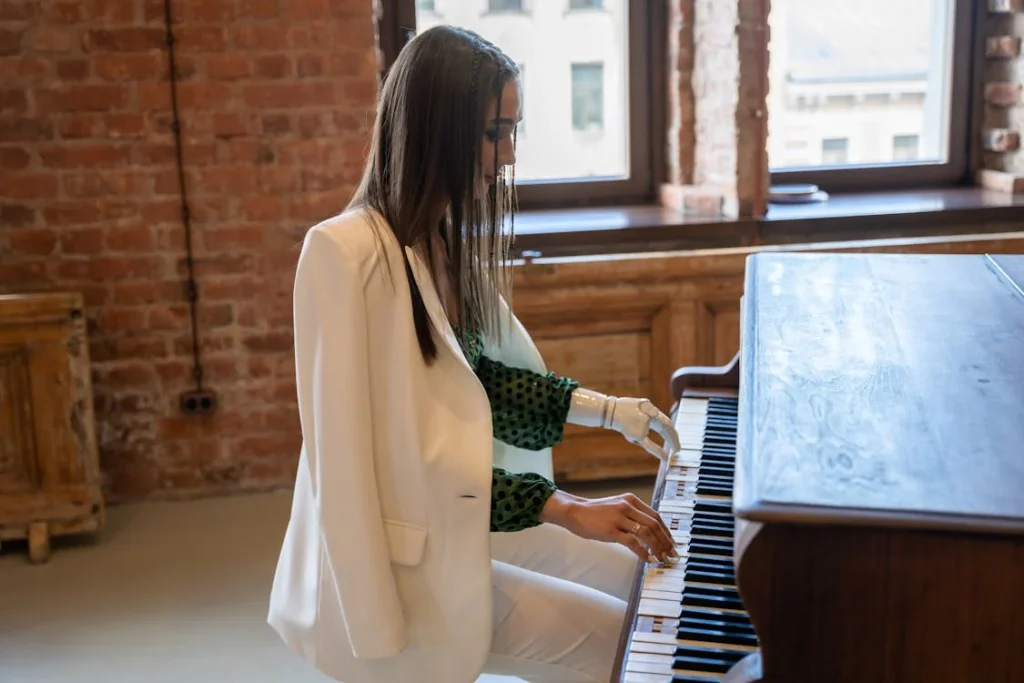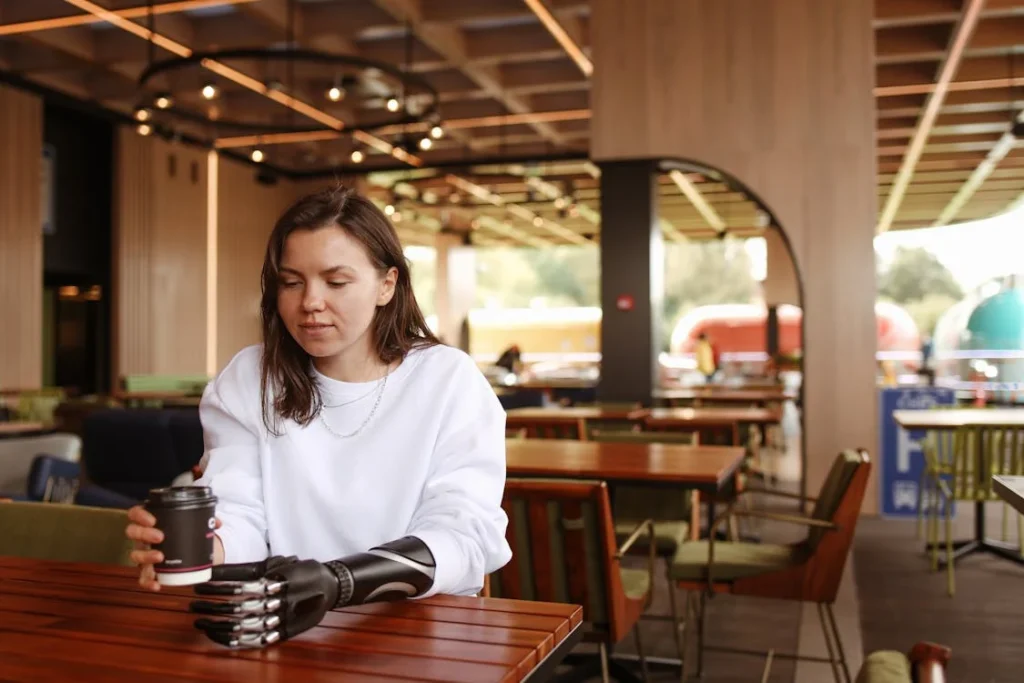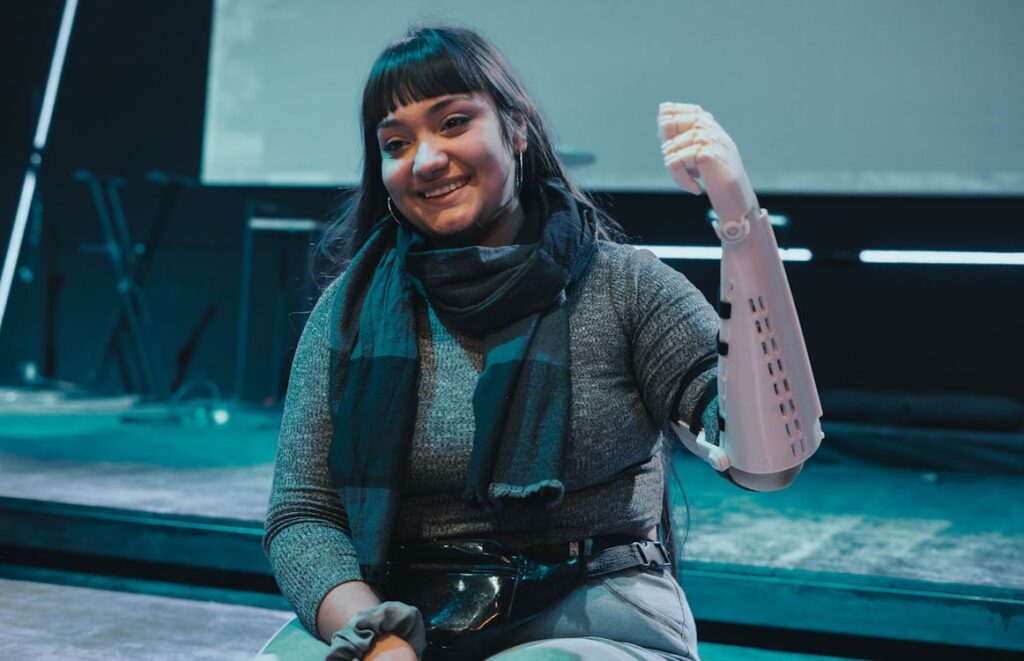When someone loses a hand or part of their arm, it’s not just the body that changes. The brain must also find a new way to talk to the muscles. This is where something amazing happens. Even after limb loss, the brain still remembers what gripping felt like. It remembers how you used to hold a pencil, lift a glass of water, or shake someone’s hand. That memory lives on. And it plays a big role in learning how to use a bionic hand.
At Robobionics, we’ve spent years studying this connection. We’ve worked closely with users, doctors, and engineers to understand how the brain, muscles, and technology can come together to bring back movement. Not just any movement, but the kind that feels natural. The kind that lets you do things without thinking too hard.

The Brain Never Forgets: Why Muscle Memory Stays Alive
How the Brain Stores Movement
Most people think memory only means remembering faces, facts, or phone numbers. But the brain also remembers actions. Things like riding a bicycle, typing, or tying your shoelaces live in a part of the brain called the motor cortex. Once you learn how to do them, you don’t need to think too hard. Your muscles just know.
This is what we call muscle memory. It’s not stored in your muscles, really—but in the way your brain and nerves talk to your muscles. This memory gets stronger the more you repeat an action. That’s why people say, “It’s like riding a bike.” Because even after years, your brain still knows how to send the right signals.
When someone loses a hand, the brain still remembers how to move it. That part doesn’t disappear. In fact, many amputees say they can still “feel” their missing hand, especially at first. They can even imagine moving each finger. That feeling is real. It’s a sign that the brain’s map of the hand is still there.
Why This Matters for Bionic Control
This is where things get exciting. A bionic hand, like the ones we build at Robobionics, doesn’t need you to learn everything from scratch. It taps into those old brain patterns. You think about gripping, and your brain sends the same signals it used to send. The muscles in your arm still react. And that’s where our technology listens.
We use special sensors—called EMG sensors—that sit on your skin. These sensors pick up the tiny electrical signals your muscles make when you try to move your missing hand. You might not even notice those movements, but they’re happening. And with the right training, those signals can control a bionic hand.
So even though your physical hand is gone, your mental map of movement is still active. That gives you a huge head start in learning to use a bionic device. You’re not starting at zero—you’re picking up where you left off.
Muscle Memory in Action: A Real Story
One of our users, Ramesh, lost his right hand in a factory accident. He had used that hand for everything—eating, working, even writing. When he got his Grippy Bionic Hand, he was nervous. He thought it would feel strange. But during his first training session, something amazing happened.
We asked him to “imagine holding a pen.” He closed his eyes and thought about it. His forearm muscles moved just slightly. Our sensors picked up those signals, and the bionic hand closed around a real pen. He opened his eyes and smiled. “It feels like mine,” he said.
That’s muscle memory at work. Ramesh didn’t have to learn how to hold a pen again. His brain already knew. Our job was simply to build a hand smart enough to listen.

Rebuilding the Connection: From Thought to Movement
Training Your Brain to Trust the Hand Again
Even though the brain remembers how to move, it still needs time to trust the bionic hand. In the beginning, the connection feels new. You may wonder, “Did I grip that tightly enough?” or “Will the hand do what I just imagined?” These are common thoughts. And they fade with practice.
At Robobionics, we guide users through a simple but powerful training process. It’s not just about pressing buttons or learning commands. It’s about rebuilding trust between the mind and the hand.
We begin with mental exercises where users simply think about common actions—like gripping a cup, holding a spoon, or waving. These thoughts create signals, even if there’s no movement. And the sensors begin learning how your body talks.
Once the signals are clear, we link them to specific grips. So when you think “grip,” the hand starts to close. At first, you might need to focus hard. But after a few sessions, your brain and muscles adjust. You begin to act, not think. That’s when the real magic starts. The bionic hand becomes a part of you—not a tool you’re operating.
This is where muscle memory evolves. It doesn’t just repeat what the brain used to know. It begins to update the memory, making room for new ways of using the hand.
How Muscles Adapt to the New Role
Your muscles are like smart rubber bands. When they’re not used for a while, they weaken. But once they’re active again, they quickly adapt. In the case of prosthetic users, the muscles near the residual limb often go unused. That’s why we focus heavily on early reactivation.
The moment a user starts sending signals—no matter how faint—the muscle fibers begin firing again. Blood flow increases. Nerve endings start working harder. Over time, the muscles become more responsive. The signals get clearer, stronger, more stable. This helps the sensors detect movement faster and more accurately.
Even small changes—like flexing a finger that isn’t there—can trigger positive growth. In fact, this process is not just physical. It helps emotionally too. As users feel their body responding, they regain a sense of ownership. They stop thinking of the limb as “missing” and start thinking of it as “adapting.”
We’ve seen users go from weak muscle signals to full control in just a few weeks. One user, Neha, started with only one readable signal. But by week four, she could switch between three grip modes using only her thoughts. Her body learned to speak the new language—and it did so faster than anyone expected.
The Role of Repetition in Rewiring the Brain
In neuroscience, there’s a phrase: “neurons that fire together, wire together.” This means that the more you repeat a thought or action, the stronger the brain’s connection becomes. This principle is at the heart of bionic hand training.
When you repeatedly use a certain grip—say, the precision grip for holding a pen—your brain strengthens the link between the thought and the action. The hand becomes faster. The response feels smoother. And you start using it without thinking.
But repetition isn’t boring. At Robobionics, we make it purposeful. Instead of just opening and closing the hand, we encourage users to practice real tasks—like brushing teeth, folding clothes, or typing on a keyboard. These actions not only help the brain relearn control, but also bring back independence.
With every successful task, confidence grows. And as confidence grows, effort decreases. What once felt like a challenge becomes part of daily routine.
One man told us, “At first, I had to look at the hand every time. Now, I pick up my phone without even thinking about it.” That’s the power of repetition guided by purpose.
Bionic Feedback Loops: Listening, Adapting, Improving
While the user’s brain is learning, the bionic hand is learning too. That’s one of the most exciting parts of modern prosthetic control. The Grippy Bionic Hand includes a smart system that reads signal patterns over time. It notices how you use it—when you press harder, when you switch grips, how long you hold.
As the system gathers data, it begins to optimize itself. So if your signals are slightly off one day—maybe because you’re tired or sore—the hand still knows what you meant to do. It fills in the gaps, much like autocorrect on a smartphone. This keeps the experience smooth, even when your body has an off day.
This kind of feedback loop builds trust. Users feel seen and understood. They don’t have to be perfect all the time—the system has their back. And over time, both the brain and the bionic system work as a team.
We even offer a training mode in the companion app, where users can watch how their signals change. Some find it motivating. Others just enjoy the feeling of progress. But all agree—it’s empowering to see how your own brain is rebuilding your grip, step by step.

Overcoming Mental Barriers: Confidence, Comfort, and Control
Why Mindset Shapes the Recovery Journey
Regaining grip isn’t just about muscle and signal. It’s also about believing that movement is possible again. After an amputation, many people struggle with doubt. They worry about being seen differently. They question whether they’ll ever return to the life they knew. This emotional weight can quietly block progress—even when the brain and muscles are ready.
That’s why, at Robobionics, we work closely with users to build not just control, but confidence. Every time a person learns to grip again, it’s not just a motor skill—it’s a win. A moment that says, “Yes, I can do this.”
We often meet users who feel nervous about starting. They’ve heard stories about stiff prosthetics, long learning curves, or lack of support. Some are even afraid to hope. But once they see how their brain still responds—once they watch a bionic hand follow their thoughts—they feel a shift. The doubt begins to lift. Control returns, and with it, belief.
We’ve learned that restoring movement is 50% physical and 50% emotional. That’s why we place so much value on small wins. Holding a toothbrush, clicking a pen, tying a loose knot—each task brings a smile, a sense of progress, and a reason to keep going.
Real-World Progress Happens One Task at a Time
Learning to grip again isn’t about lab tests or fancy demos. It’s about the small, daily actions that make life easier. And the brain learns best when those actions are meaningful.
In our training centers, we avoid robotic routines. Instead, we ask questions like, “What’s one thing you miss doing with your hand?” For some, it’s making chai. For others, it’s buttoning a shirt or shaking someone’s hand without flinching.
By focusing on what matters to the user, we turn therapy into something personal. The user chooses the task. We build a path toward it. And the brain begins wiring itself for success—not out of duty, but out of desire.
Take the case of Salma, a schoolteacher from Lucknow. She wanted to hold chalk again. That was her goal. We trained her on the tripod grip, adjusted the EMG sensitivity, and practiced for three weeks. The day she picked up a stick of chalk and wrote her name on the blackboard again, she cried. “It felt like I got my hand—and my classroom—back,” she told us.
That’s not just bionic control. That’s recovery with meaning.
Phantom Limbs and Rewriting the Brain’s Map
Another interesting part of this journey is dealing with phantom limb sensations. Many amputees feel pain, itching, or movement in the part of the limb that’s no longer there. It can be confusing and uncomfortable.
But recent studies—and our own user stories—show that these sensations are actually signs of the brain’s memory in action. The brain still believes the limb exists, because it hasn’t fully rewired yet. And that’s not always a bad thing.
In fact, we use these sensations as starting points for bionic control. If a user says, “I feel my thumb moving when I think about gripping,” we target that signal. We train the sensors to recognize it. Over time, the brain stops treating that movement as “phantom” and starts seeing it as real again—because it’s connected to action.
This process, called neuroplasticity, is the brain’s natural ability to adapt. And it’s the same reason stroke patients relearn how to walk, or why kids can switch languages faster than adults. The brain wants to learn—it just needs direction.
Bionic hands give it that direction. They tell the brain: “Yes, that movement matters. Yes, we’re using it. Keep it alive.”
We’ve seen phantom pain reduce over time when users begin regular bionic training. Why? Because the brain is no longer confused. It sees clear input and output. It learns to let go of the old signals and focus on the new, useful ones.
So even discomfort can lead to progress—if guided correctly.
Support Systems That Reinforce the Learning Curve
No one learns alone. And no one should. That’s why we’ve created a full support network around the Grippy Bionic Hand. From the moment someone receives their device, they’re never on their own.
Our trainers walk each user through signal training, grip switching, and muscle strengthening. We offer video sessions, in-person therapy, and hands-on workshops. But more than that, we stay in touch. Users can send us questions, videos, or even signal logs through our app. And our team responds with guidance, feedback, or adjustments.
The reason is simple: learning to grip again is a journey. And like any journey, it comes with good days and bad ones. We want users to know they’re supported through both.
Some of our best improvements have come from user stories. Like when someone in Punjab couldn’t hold a cricket bat firmly, we modified the finger design. Or when a student in Bangalore asked if she could write longer without hand fatigue, we redesigned the wrist joint.
In every case, the learning curve became a loop of feedback and improvement—from user to brain to hand, and back again.
The Long-Term Impact of Regaining Control
Once a user has learned to grip again, the effects ripple through their life. They don’t just pick things up—they pick up self-worth. They get back to cooking, parenting, studying, and working. They travel with more ease. They stop hiding their limb. They start feeling seen again.
And most importantly, they gain a sense of control—not just over their hand, but over their story.
We believe that every person deserves to write their own comeback. And with the right blend of brain power, bionic design, and belief, they can.

Designing for the Mind: How Technology Makes Learning Intuitive
Why Simplicity Matters in High-Tech Hands
Advanced doesn’t have to mean complicated. In fact, the more natural a bionic hand feels, the better the brain can work with it. When we design at Robobionics, we ask ourselves a simple question: Can this hand feel like part of the user from day one?
That’s why every part of the Grippy Bionic Hand is made to support the brain’s learning. From the placement of sensors to the speed of grip activation, everything is designed to feel familiar—even if the device itself is brand new.
Users shouldn’t need to memorize controls or tap through confusing menus. They should just think, move, and see the result. The faster the brain sees action from its command, the stronger the connection becomes. This creates a feeling of flow, where users stop noticing the hand as a machine and start trusting it as an extension of their body.
We also focus on consistency. When a signal creates the same result every time, the brain quickly locks into a pattern. That predictability is vital in the early weeks of training. If a grip sometimes works and sometimes doesn’t, users lose trust. But when the hand behaves just like the brain expects, something clicks. Learning accelerates.
That’s why we use stabilized EMG signal reading with built-in filters. These systems smooth out noise and reduce false triggers. So even if a user’s signal is weak or shaky at first, the hand still performs cleanly. And that reinforces belief: My brain can still do this.
Creating Visual and Sensory Feedback for Reinforcement
Another tool we use to help the brain learn faster is feedback. Not just visual, but sensory. When the bionic hand responds to a command, we add small cues that tell the user: “Yes, you did it right.”
These cues come in the form of gentle vibrations, grip pressure, or slight resistance. Think of it like the click you feel on a keyboard or the buzz on your phone. These subtle signals reassure the brain that the action is complete. They create a mini reward loop.
Over time, the brain begins to associate certain sensations with certain grips. That’s when response becomes automatic. A user might not even look at their hand—they just know, by feel, what it’s doing.
We also include visual training tools in the Robobionics app. Users can watch their EMG signals in real time, see which grip is active, and track how long they hold each position. Some users find it fun, even addictive. Like leveling up in a game. Others just like knowing how far they’ve come. Either way, it gives the brain something powerful—a picture of progress.
When the brain can see, feel, and trust the result of its efforts, learning becomes natural.
Personalized Grip Mapping: Teaching the Hand Your Style
Everyone grips differently. One person might press harder, another softer. Some people prefer speed. Others want full control. That’s why we don’t force users into preset modes. We let them teach the hand their own rhythm.
With our grip mapping system, the Grippy Hand learns how each user sends signals. During training, we fine-tune the sensors to recognize specific patterns from that user’s muscles. It’s like giving the hand your personal accent. You speak in your own way—and the hand understands.
This approach is especially helpful for users with unusual muscle structures, scar tissue, or nerve changes. Instead of making them adjust to the device, we adjust the device to them.
And as their signals grow stronger or more stable, the hand evolves with them. This means users aren’t locked into one setup forever. They can grow, adapt, and explore new abilities.
We’ve had users start with just one grip and later expand to three or four. Not because we pushed them—but because their own brain and muscles got stronger. That’s the real goal: to enable natural growth, not force artificial limits.
The Science Behind Brain-Adaptive Prosthetics
Modern prosthetics don’t just follow your signals—they learn from them. The science behind this is called adaptive control. It means the hand tracks how you use it, notices your preferences, and makes small changes in the background.
If you tend to press harder when gripping, the hand remembers. If your signals fade in the evening, it compensates by adjusting sensitivity. This kind of learning system doesn’t replace your effort—it supports it.
It’s like having a smart teammate who learns your pace and adjusts to match. That gives users more freedom, and it reduces frustration. No one wants to feel like they’re constantly “training” their hand. Adaptive systems allow you to simply live, while the tech keeps improving silently.
We’ve integrated this learning into our firmware updates, so even users who’ve had the Grippy for over a year keep getting smarter performance. One user even called it “the prosthetic that evolves with me.” And that’s exactly what we want—a device that grows alongside the person, not ahead or behind.
What the Brain Teaches Us
As much as we teach users how to operate the Grippy, their brains teach us, too. Every time someone learns a new grip, every time a signal becomes more refined, we learn something about human potential. About resilience. About the power of the mind to adapt and rebuild.
Our engineering team works closely with therapists and neurologists because we believe prosthetics are not just machines. They’re tools shaped by the deep memory of movement that lives in all of us. That memory doesn’t disappear with trauma. It waits. It listens. And when given the right tool, it rises again.
That’s why we’re committed not just to innovation, but to understanding. We don’t just want to build better hands. We want to unlock better futures—one brain, one user, one grip at a time.

Growing Up Bionic: How Young Brains Learn to Grip Faster
Why Early Introduction Matters for Lifelong Bionic Control
When it comes to learning, younger brains have a secret advantage: they are naturally wired to adapt. Childhood and adolescence are the most plastic stages of brain development, meaning the brain can form new connections and habits much faster than in adulthood.
This is exactly why introducing a bionic hand early—whether in childhood or teenage years—can make a massive difference in how naturally someone learns to grip, grasp, and move again.
At Robobionics, we’ve seen this over and over. Children fitted with the Grippy Bionic Hand often show faster reaction times, quicker muscle signal development, and smoother transitions between grip patterns. What’s even more incredible is that they don’t overthink it. Their brains don’t fight the technology. They just flow with it.
That’s because kids don’t have the same emotional baggage or learned limitations that adults often carry post-amputation. Their minds are still forming their understanding of the body. So when we introduce a bionic hand early, that device becomes part of their body image right from the start.
Learning Through Play, Not Pressure
One of the most effective ways to help children learn bionic control is to embed it into play. Unlike adults, who often focus on function and performance, kids explore movement through curiosity. They try new grips while stacking blocks, picking up snacks, or turning pages in a book. And because their brains treat these actions like a game, they quickly refine the muscle patterns needed for smoother control.
In our pediatric training programs, we use toys, colors, drawing activities, and interactive games that reward consistent EMG signals. Children begin associating movement with fun rather than effort. This approach builds both skill and confidence—two essential ingredients for long-term prosthetic use.
We also encourage families to engage in shared tasks. A parent might guide their child through brushing teeth together. A sibling might play catch or video games with them. These social moments aren’t just practice—they help the brain cement the hand as a normal part of life.
Confidence That Carries Into Adulthood
The earlier someone learns to move with confidence, the less likely they are to abandon the device later. Children who grow up using a bionic hand often retain their motor control longer, with stronger EMG signals and faster reaction times. They also tend to develop a stronger sense of independence and a healthier body image.
This matters a lot during teenage years—a phase when self-consciousness peaks. Amputees who’ve used a prosthetic from childhood are more likely to raise their hand in class, participate in sports, or even join dance teams. Not because they’re fearless, but because they’ve already built the muscle memory and emotional comfort needed to move freely in front of others.
One teenage user in Pune told us, “I don’t even think about the hand anymore. It just does what I want. People at school ask questions, but I show them how it works and they get excited. It’s become part of my story.”
That kind of confidence can’t be rushed—but it can be nurtured if started early.
Designing the Grippy for Young Users
We’ve made special design adjustments to make the Grippy more child-friendly. The hand is lighter, with smaller finger widths for better control of small objects. The socket is made with softer edges and flexible materials to accommodate growing limbs. And the grip presets are tuned for low-force interactions—perfect for things like picking up crayons, zip-locks, or tiny game pieces.
We’ve also introduced custom skin covers in fun patterns and colors, so the hand doesn’t just feel functional—it feels personal. Kids can pick styles that reflect their personality. One of our users chose a Spider-Man theme; another wanted their favorite cartoon printed on the shell. These details might seem small, but they play a huge role in helping a child embrace their prosthesis.
Parental Guidance and Long-Term Support
No child learns alone. Parents are an essential part of the process—encouraging movement, guiding practice, celebrating progress. That’s why we include parent training in every pediatric fitting. We show families how to clean the device, charge it properly, adjust grip settings, and recognize early signs of signal fatigue.
We also provide regular check-ins, especially during growth spurts. A limb that fits well in March may need resizing by October. Our modular system ensures these changes are quick and cost-effective, without needing a full replacement.
The goal is clear: to help children grow into adults who see their bionic hand not as a crutch, but as a companion—one that’s been with them through each chapter of life.

Changing the Conversation: How Bionic Hands Are Redefining Disability in India
From Sympathy to Respect: A New Lens on Limb Difference
For decades, disability in India has been seen through a narrow lens—often framed with pity, fear, or overprotection. People with limb differences were expected to “manage” rather than thrive. The idea of someone with a prosthetic hand leading a company, climbing a mountain, or even riding a scooter was, for many, hard to imagine.
But times are changing.
With the arrival of smart prosthetics like the Grippy Bionic Hand, the public is beginning to see something very different. They see users gripping tools, swiping metro cards, cooking on reels, even lifting weights. What was once considered a limitation is now becoming a badge of strength. Bionic control doesn’t just restore movement—it sparks curiosity, confidence, and admiration.
This shift is crucial. Because when society’s gaze changes—from sympathy to respect—everything else changes too. Schools become more welcoming. Workplaces open their doors. Families stop hiding amputees and start celebrating their growth.
The Grippy is not just a hand. It’s a conversation starter. And what it’s starting is long overdue.
Public Awareness Through Visibility
One of the reasons stigma around prosthetics has lasted so long is simple: people don’t see them. Traditional prosthetic hands were either hidden under gloves or looked like stiff mannequins. Many users avoided wearing them in public because they looked unnatural or drew unwanted attention.
We tackled that problem head-on by designing the Grippy to look intentional, not invisible.
With sleek design, natural movements, and custom skins, the Grippy becomes something users are proud to wear. They want people to ask about it. And when someone does, it leads to a powerful moment: not one of shame, but of show-and-tell.
We’ve seen Grippy users take the lead at job fairs, college orientations, even on social media. They post videos explaining how it works. They teach their classmates how grip modes operate. They use hashtags like #BionicInIndia and #GrippyLife. And the response is overwhelming—comments filled with admiration, curiosity, and inspiration.
This kind of visibility matters. It creates a new image of what it means to live with a bionic hand. It tells others, especially young amputees, “This can be your story too.”
Breaking Barriers in Education and Employment
India still has a long way to go in terms of accessibility—but change is underway. And smart prosthetics are playing a big part in it.
With better grip control, students can now take handwritten exams, carry books, use lab equipment, and participate in sports. This opens up streams that were once seen as “impractical” for someone with a limb difference—engineering, design, science, hospitality. No more steering students into “safe” fields. The Grippy helps put real options back on the table.
In the workplace, users with the Grippy can handle tools, operate computers, shake hands with clients, and navigate public transit—all with less effort and more dignity. This is slowly pushing employers to change their views. They’re starting to see ability, not disability.
One of our users, an HR manager in Mumbai, shared how she now uses her Grippy to operate biometric systems at the office and sign paperwork during meetings. “It’s not a limitation anymore,” she told us. “In fact, it gets people talking about innovation—and that’s a great place to start.”
When tools change, so do expectations. And that’s what we’re seeing—expectations rising, not falling.
Family Mindsets and Generational Shifts
Perhaps the biggest transformation we’re witnessing is happening within homes. In India, families are tight-knit. That closeness can be comforting—but also overwhelming when someone experiences limb loss. Many families, out of love or fear, become overprotective. They worry. They hover. Sometimes, they unintentionally limit recovery by doing too much for the user.
But when families see what the Grippy can do, something shifts. Parents watch their children button shirts again. Spouses see their partners open jars or drive once more. And slowly, the fear gives way to belief.
We now include family members in the training process—not just as helpers, but as believers. We teach them how to support progress without stepping in too much. We help them see the prosthetic as a path to growth, not a reminder of loss.
And this new understanding doesn’t stop with one family. It ripples out—to neighbors, schools, employers, and friends. The more people see a bionic hand in action, the more they realize this: the future isn’t about hiding prosthetics—it’s about wearing them proudly.
A New Cultural Identity: Proud, Capable, and Visible
We believe that prosthetics aren’t just medical devices—they’re cultural symbols. They show what a society values: inclusion, technology, freedom. That’s why we’re so focused on how the Grippy fits into the Indian way of life.
Whether it’s learning to do a namaste, gripping a pooja thali, kneading dough, or riding pillion on a bike—our hand is designed not just to work, but to belong.
Because in India, belonging matters.
When users tell us that their prosthetic doesn’t make them feel different—it makes them feel stronger—we know we’re on the right path. The Grippy isn’t just helping individuals grip again. It’s helping a whole nation reshape how it sees disability, control, and human potential.
Conclusion
Muscle memory never truly disappears—it waits for a signal, a chance, a second act. And with the Grippy Bionic Hand, that moment arrives. Every grip, every movement, every rediscovered task is proof that the brain remembers, the body adapts, and the human spirit endures.
At Robobionics, we don’t just build prosthetics. We build bridges between thought and action, between doubt and confidence, between what was lost and what can be regained. Whether you’re a child learning to write again, a professional returning to work, or someone rediscovering everyday joy—the path to control starts in your mind.
And when the brain leads, the hand follows.
This is more than technology. This is your comeback.



